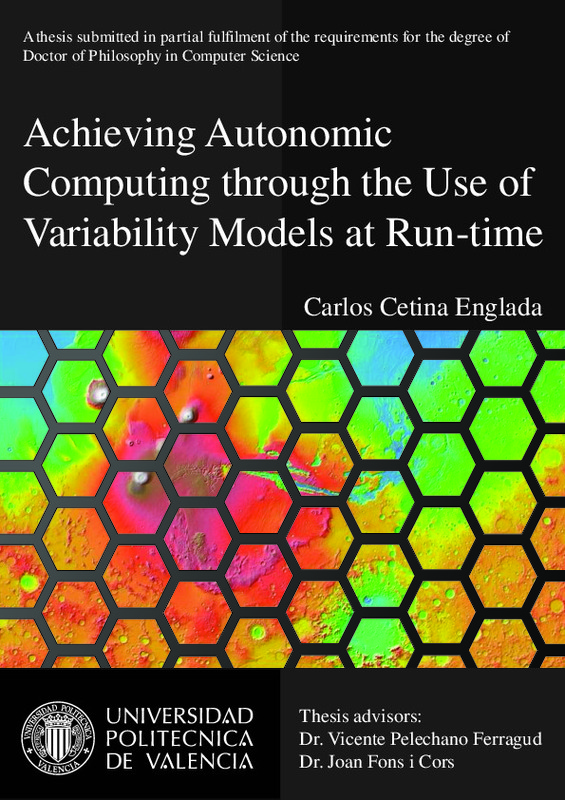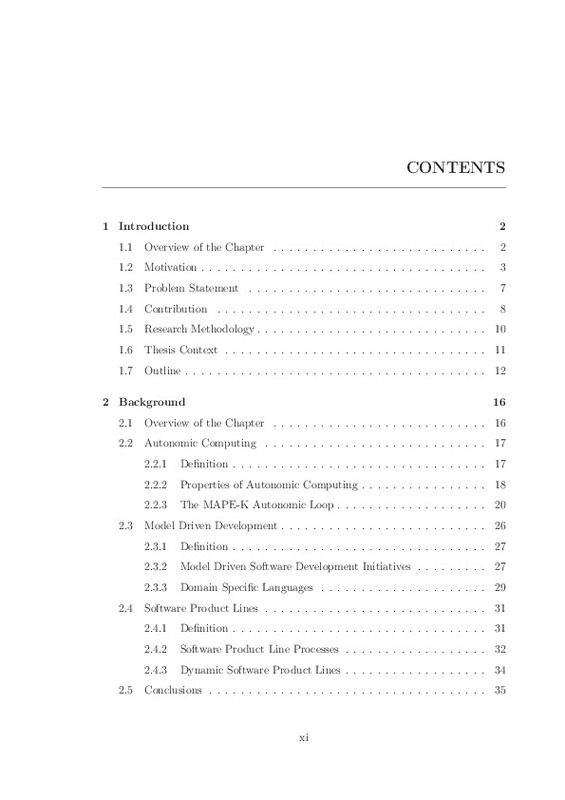- RiuNet repositorio UPV
- :
- Investigación
- :
- Tesis doctorales
- :
- Ver ítem
JavaScript is disabled for your browser. Some features of this site may not work without it.
Buscar en RiuNet
Listar
Mi cuenta
Estadísticas
Ayuda RiuNet
Admin. UPV
Achieving Autonomic Computing through the Use of Variability Models at Run-time
Mostrar el registro sencillo del ítem
Ficheros en el ítem
| dc.contributor.advisor | Pelechano Ferragud, Vicente
|
es_ES |
| dc.contributor.advisor | Fons Cors, Joan Josep
|
es_ES |
| dc.contributor.author | Cetina Englada, Carlos
|
es_ES |
| dc.date.accessioned | 2010-04-15T06:52:40Z | |
| dc.date.available | 2010-04-15T06:52:40Z | |
| dc.date.created | 2010-03-26T09:00:00Z | es_ES |
| dc.date.issued | 2010-04-15T06:52:02Z | es_ES |
| dc.identifier.uri | http://hdl.handle.net/10251/7484 | |
| dc.description.abstract | Increasingly, software needs to dynamically adapt its behavior at run-time in response to changing conditions in the supporting computing infrastructure and in the surrounding physical environment. Adaptability is emerging as a necessary underlying capability, particularly for highly dynamic systems such as context-aware or ubiquitous systems. By automating tasks such as installation, adaptation, or healing, Autonomic Computing envisions computing environments that evolve without the need for human intervention. Even though there is a fair amount of work on architectures and their theoretical design, Autonomic Computing was criticised as being a \hype topic" because very little of it has been implemented fully. Furthermore, given that the autonomic system must change states at runtime and that some of those states may emerge and are much less deterministic, there is a great challenge to provide new guidelines, techniques and tools to help autonomic system development. This thesis shows that building up on the central ideas of Model Driven Development (Models as rst-order citizens) and Software Product Lines (Variability Management) can play a signi cant role as we move towards implementing the key self-management properties associated with autonomic computing. The presented approach encompass systems that are capable of modifying their own behavior with respect to changes in their operating environment, by using variability models as if they were the policies that drive the system's autonomic recon guration at runtime. Under a set of recon guration commands, the components that make up the architecture dynamically cooperate to change the con guration of the architecture to a new con guration. This work also provides the implementation of a Model-Based Recon guration Engine (MoRE) to blend the above ideas. Given a context event, MoRE queries the variability models to determine how the system should evolve, and then it provides the mechanisms for modifying the system. | en_EN |
| dc.language | Inglés | es_ES |
| dc.publisher | Universitat Politècnica de València | es_ES |
| dc.rights | Reserva de todos los derechos | es_ES |
| dc.source | Riunet | |
| dc.subject | Autonomic computing | es_ES |
| dc.subject | Model driven development | es_ES |
| dc.subject | Software product line | es_ES |
| dc.subject | Variability modelling | es_ES |
| dc.subject | Model at run-time | es_ES |
| dc.subject | Pervasive system | es_ES |
| dc.subject | Smart home | es_ES |
| dc.subject.classification | LENGUAJES Y SISTEMAS INFORMATICOS | es_ES |
| dc.title | Achieving Autonomic Computing through the Use of Variability Models at Run-time | |
| dc.type | Tesis doctoral | es_ES |
| dc.identifier.doi | 10.4995/Thesis/10251/7484 | es_ES |
| dc.rights.accessRights | Abierto | es_ES |
| dc.contributor.affiliation | Universitat Politècnica de València. Departamento de Sistemas Informáticos y Computación - Departament de Sistemes Informàtics i Computació | es_ES |
| dc.description.bibliographicCitation | Cetina Englada, C. (2010). Achieving Autonomic Computing through the Use of Variability Models at Run-time [Tesis doctoral]. Universitat Politècnica de València. https://doi.org/10.4995/Thesis/10251/7484 | es_ES |
| dc.description.accrualMethod | Palancia | es_ES |
| dc.type.version | info:eu-repo/semantics/acceptedVersion | es_ES |
| dc.relation.tesis | 3264 | es_ES |
Este ítem aparece en la(s) siguiente(s) colección(ones)
-
Tesis doctorales [5389]







![Text file [Text]](/themes/UPV/images/text.png)


